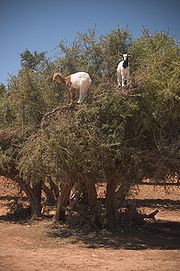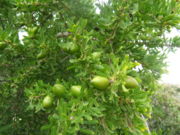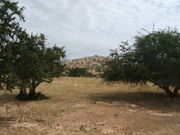
Argan
Encyclopedia
The Argan is a species of tree
endemic to the calcareous
semi-desert Sous
valley of southwestern Morocco
and to the Algerian region of Tindouf
in the western Mediterranean region. It is the sole species in the genus Argania.
Argan grows to 8-10 metres high and live up to 150–200 years. They are thorny, with gnarled trunks. The leaves
are small, 2–4 cm long, oval with a rounded apex. The flower
s are small, with five pale yellow-green petals; flowering is in April. The fruit
is 2–4 cm long and 1.5–3 cm broad, with a thick, bitter peel surrounding a sweet-smelling but unpleasantly flavoured layer of pulpy pericarp. This surrounds the very hard nut, which contains one (occasionally two or three) small, oil-rich seeds. The fruit takes over a year to mature, ripening in June to July of the following year.
Biosphere reserve
. Their area has shrunk by about half during the last 100 years, owing to charcoal-making, grazing, and increasingly intensive cultivation. The best hope for the conservation of the trees may lie in the recent development of a thriving export market for argan oil
as a high-value product, although this has been questioned recently .
Argan is also grown in Israel
, in the Arava
and Negev
.
 In some parts of Morocco, argan takes the place of the olive
In some parts of Morocco, argan takes the place of the olive
as a source of forage
, oil
, timber
and fuel in Berber
society. Especially near Essaouira
, the argan tree is frequently climbed by goats http://www.the-tree.org.uk/SpecialBranch/InTree/goats.htm.
 Argan fruit falls in July, when black and dry. Until this happens, goats are kept out of the argan woodlands by wardens. Rights to collect the fruit are controlled by law and village traditions. The leftover nut is gathered after consumption by goats.
Argan fruit falls in July, when black and dry. Until this happens, goats are kept out of the argan woodlands by wardens. Rights to collect the fruit are controlled by law and village traditions. The leftover nut is gathered after consumption by goats.
 Argan oil is produced by several women's co-operatives in the southwestern parts of Morocco. The most labour-intensive part of oil-extraction is removal of the soft pulp (used to feed animals) and the cracking by hand, between two stones, of the hard nut. The seeds are then removed and gently roasted. This roasting accounts for part of the oil's distinctive, nutty flavour.
Argan oil is produced by several women's co-operatives in the southwestern parts of Morocco. The most labour-intensive part of oil-extraction is removal of the soft pulp (used to feed animals) and the cracking by hand, between two stones, of the hard nut. The seeds are then removed and gently roasted. This roasting accounts for part of the oil's distinctive, nutty flavour.
The traditional technique for oil extraction is to grind the roasted seeds to paste, with a little water, in a stone rotary quern. The paste is then squeezed by hand in order to extract the oil. The extracted paste is still oil-rich and is used as animal feed. Oil produced this way can be stored and used for 3–6 months, and will be produced as needed in a family, from a store of the kernels, which will keep for 20 years unopened. Dry-pressing is becoming increasingly important for oil produced for sale, as this method allows for faster extraction, and the oil produced can be used for 12–18 months after extraction.
The oil contains 80% unsaturated fatty acids, is rich in essential fatty acids and is more resistant to oxidation than olive oil. Argan oil is used for dipping bread, on couscous
, salad
s and similar uses. A dip for bread known as amlou is made from argan oil, almond
s and peanut
s, sometimes sweetened by honey
or sugar. The unroasted oil is traditionally used as a treatment for skin diseases, and has become favoured by European cosmetics manufacturers.
Argan oil is sold in Morocco as a luxury item, and is difficult to find for sale outside the region of production. The product is of increasing interest to cosmetics companies in Europe. It used to be difficult to buy the oil outside Morocco, but since 2001-2002 it has become a fashionable product in Europe and North America. It is now widely available in specialist shops and occasionally in supermarkets. Its price (USD
$40-50 for 500 ml) is notable compared to other oils.
Argan oil contains:
Tree
A tree is a perennial woody plant. It is most often defined as a woody plant that has many secondary branches supported clear of the ground on a single main stem or trunk with clear apical dominance. A minimum height specification at maturity is cited by some authors, varying from 3 m to...
endemic to the calcareous
Calcareous
Calcareous is an adjective meaning mostly or partly composed of calcium carbonate, in other words, containing lime or being chalky. The term is used in a wide variety of scientific disciplines.-In zoology:...
semi-desert Sous
Sous
The Sous or Souss is a region in southern Morocco. Geologically, it is the alluvial basin of the Oued Sous , separated from the Sahara by the Anti-Atlas Mountains...
valley of southwestern Morocco
Morocco
Morocco , officially the Kingdom of Morocco , is a country located in North Africa. It has a population of more than 32 million and an area of 710,850 km², and also primarily administers the disputed region of the Western Sahara...
and to the Algerian region of Tindouf
Tindouf
Tindouf is the main town in Tindouf Province, Algeria, close to the Mauritanian and Moroccan borders. The region is considered of strategic significance, and it houses Algerian military bases. Since 1975, it also contains several Sahrawi refugee camps operated by the Polisario Front a guerrilla...
in the western Mediterranean region. It is the sole species in the genus Argania.
Argan grows to 8-10 metres high and live up to 150–200 years. They are thorny, with gnarled trunks. The leaves
Leaf
A leaf is an organ of a vascular plant, as defined in botanical terms, and in particular in plant morphology. Foliage is a mass noun that refers to leaves as a feature of plants....
are small, 2–4 cm long, oval with a rounded apex. The flower
Flower
A flower, sometimes known as a bloom or blossom, is the reproductive structure found in flowering plants . The biological function of a flower is to effect reproduction, usually by providing a mechanism for the union of sperm with eggs...
s are small, with five pale yellow-green petals; flowering is in April. The fruit
Fruit
In broad terms, a fruit is a structure of a plant that contains its seeds.The term has different meanings dependent on context. In non-technical usage, such as food preparation, fruit normally means the fleshy seed-associated structures of certain plants that are sweet and edible in the raw state,...
is 2–4 cm long and 1.5–3 cm broad, with a thick, bitter peel surrounding a sweet-smelling but unpleasantly flavoured layer of pulpy pericarp. This surrounds the very hard nut, which contains one (occasionally two or three) small, oil-rich seeds. The fruit takes over a year to mature, ripening in June to July of the following year.
Cultivation
In Morocco arganeraie forests now cover some 8,280 km² and are designated as a UNESCOUNESCO
The United Nations Educational, Scientific and Cultural Organization is a specialized agency of the United Nations...
Biosphere reserve
Biosphere reserve
The Man and the Biosphere Programme of UNESCO was established in 1971 to promote interdisciplinary approaches to management, research and education in ecosystem conservation and sustainable use of natural resources.-Development:...
. Their area has shrunk by about half during the last 100 years, owing to charcoal-making, grazing, and increasingly intensive cultivation. The best hope for the conservation of the trees may lie in the recent development of a thriving export market for argan oil
Argan oil
Argan oil is an oil produced from the kernels of the argan tree, endemic to Morocco, that is valued for its nutritive, cosmetic and numerous medicinal properties. The tree, a relict species from the Tertiary age, is extremely well adapted to drought and other environmentally difficult conditions of...
as a high-value product, although this has been questioned recently .
Argan is also grown in Israel
Israel
The State of Israel is a parliamentary republic located in the Middle East, along the eastern shore of the Mediterranean Sea...
, in the Arava
Arava
Arava can refer to:*Arava, Estonia, a village in Anija Commune, Harju County, Estonia.*Arabah, a section of the Great Rift Valley between the Dead Sea and the Gulf of Aqaba in Israel and Jordan....
and Negev
Negev
The Negev is a desert and semidesert region of southern Israel. The Arabs, including the native Bedouin population of the region, refer to the desert as al-Naqab. The origin of the word Neghebh is from the Hebrew root denoting 'dry'...
.
Uses

Olive
The olive , Olea europaea), is a species of a small tree in the family Oleaceae, native to the coastal areas of the eastern Mediterranean Basin as well as northern Iran at the south end of the Caspian Sea.Its fruit, also called the olive, is of major agricultural importance in the...
as a source of forage
Fodder
Fodder or animal feed is any agricultural foodstuff used specifically to feed domesticated livestock such as cattle, goats, sheep, horses, chickens and pigs. Most animal feed is from plants but some is of animal origin...
, oil
Argan oil
Argan oil is an oil produced from the kernels of the argan tree, endemic to Morocco, that is valued for its nutritive, cosmetic and numerous medicinal properties. The tree, a relict species from the Tertiary age, is extremely well adapted to drought and other environmentally difficult conditions of...
, timber
Timber
Timber may refer to:* Timber, a term common in the United Kingdom and Australia for wood materials * Timber, Oregon, an unincorporated community in the U.S...
and fuel in Berber
Berber people
Berbers are the indigenous peoples of North Africa west of the Nile Valley. They are continuously distributed from the Atlantic to the Siwa oasis, in Egypt, and from the Mediterranean to the Niger River. Historically they spoke the Berber language or varieties of it, which together form a branch...
society. Especially near Essaouira
Essaouira
Mogador redirects here, for the hamlet in Surrey see Mogador, Surrey.Essaouira is a city in the western Moroccan economic region of Marrakech-Tensift-Al Haouz, on the Atlantic coast. Since the 16th century, the city has also been known by its Portuguese name of Mogador or Mogadore...
, the argan tree is frequently climbed by goats http://www.the-tree.org.uk/SpecialBranch/InTree/goats.htm.
Fruit

Argan oil

The traditional technique for oil extraction is to grind the roasted seeds to paste, with a little water, in a stone rotary quern. The paste is then squeezed by hand in order to extract the oil. The extracted paste is still oil-rich and is used as animal feed. Oil produced this way can be stored and used for 3–6 months, and will be produced as needed in a family, from a store of the kernels, which will keep for 20 years unopened. Dry-pressing is becoming increasingly important for oil produced for sale, as this method allows for faster extraction, and the oil produced can be used for 12–18 months after extraction.
The oil contains 80% unsaturated fatty acids, is rich in essential fatty acids and is more resistant to oxidation than olive oil. Argan oil is used for dipping bread, on couscous
Couscous
Couscous is a Berber dish of semolina traditionally served with a meat or vegetable stew spooned over it. Couscous is a staple food throughout Algeria, Morocco and Tunisia.-Etymology:...
, salad
Salad
Salad is any of a wide variety of dishes, including vegetable salads; salads of pasta, legumes, eggs, or grains; mixed salads incorporating meat, poultry, or seafood; and fruit salads. They may include a mixture of cold and hot, often including raw vegetables or fruits.Green salads include leaf...
s and similar uses. A dip for bread known as amlou is made from argan oil, almond
Almond
The almond , is a species of tree native to the Middle East and South Asia. Almond is also the name of the edible and widely cultivated seed of this tree...
s and peanut
Peanut
The peanut, or groundnut , is a species in the legume or "bean" family , so it is not a nut. The peanut was probably first cultivated in the valleys of Peru. It is an annual herbaceous plant growing tall...
s, sometimes sweetened by honey
Honey
Honey is a sweet food made by bees using nectar from flowers. The variety produced by honey bees is the one most commonly referred to and is the type of honey collected by beekeepers and consumed by humans...
or sugar. The unroasted oil is traditionally used as a treatment for skin diseases, and has become favoured by European cosmetics manufacturers.
Argan oil is sold in Morocco as a luxury item, and is difficult to find for sale outside the region of production. The product is of increasing interest to cosmetics companies in Europe. It used to be difficult to buy the oil outside Morocco, but since 2001-2002 it has become a fashionable product in Europe and North America. It is now widely available in specialist shops and occasionally in supermarkets. Its price (USD
United States dollar
The United States dollar , also referred to as the American dollar, is the official currency of the United States of America. It is divided into 100 smaller units called cents or pennies....
$40-50 for 500 ml) is notable compared to other oils.
Argan oil contains:
- 44% Oleic acidOleic acidOleic acid is a monounsaturated omega-9 fatty acid found in various animal and vegetable fats. It has the formula CH37CH=CH7COOH. It is an odorless, colourless oil, although commercial samples may be yellowish. The trans isomer of oleic acid is called elaidic acid...
- 30% Alpha-linolenic acidAlpha-linolenic acidα-Linolenic acid is an organic compound found in many common vegetable oils. In terms of its structure, it is named all-cis-9,12,15-octadecatrienoic acid. In physiological literature, it is given the name 18:3 ....
- 12% Palmitic acidPalmitic acidPalmitic acid, or hexadecanoic acid in IUPAC nomenclature, is one of the most common saturated fatty acids found in animals and plants. Its molecular formula is CH314CO2H. As its name indicates, it is a major component of the oil from palm trees . Palmitate is a term for the salts and esters of...
- 6% Stearidonic acidStearidonic acidStearidonic acid is an ω-3 fatty acid, sometimes called moroctic acid. It is biosynthesized from alpha-linolenic acid by the enzyme delta-6-desaturase. Natural sources of this fatty acid are the seed oils of hemp, blackcurrant, corn gromwell and echium, and the cyanobacterium Spirulina....
- 5% Linoleic acidLinoleic acidLinoleic acid is an unsaturated n-6 fatty acid. It is a colorless liquid at room temperature. In physiological literature, it has a lipid number of 18:2...
- 3% Myristic acidMyristic acidMyristic acid, also called tetradecanoic acid, is a common saturated fatty acid with the molecular formula CH312COOH. A myristate is a salt or ester of myristic acid....

